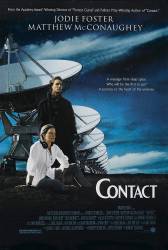Factual error: At the end, after Ellie testifies before Congress, she departs the Capitol building to a waiting limo. The media is there waiting for her. Behind the reporters appears to be the Reflecting Pool, and the Washington Monument at the far end of it. However, in reality, the Reflecting Pool is actually located between the Lincoln Memorial and the Washington Monument, not the Capitol. While there are two Reflecting Pools, the columns in the movie are the columns of the Lincoln Memorial, not the Capitol. Furthermore, the steps leading to a street in front of the reflecting pool are located at the Lincoln Memorial; the Capitol has a large green lawn between it and the street.
Suggested correction: It wasn't the Lincoln Memorial, but the Treasury Building.
Factual error: When Foster is going to Japan, a Harrier jet transports her to a ship. The ship is underway, traveling at quite a clip according to the wake. The Harrier landed on its heliport platform, facing the stern. Harriers hover, but cannot fly backwards at more than a crawl. It would have crashed.
Suggested correction: It isn't technically a harrier just another futuristic version of a VTOL aircraft. We don't know the capabilities of a fictional aircraft.
The VTOL is military, but she steps off a small commercial plane.
Factual error: The last time Eleanor Arroway talks to S.R. Haddon, he's aboard the Russian space station Mir, and Haddon explains that he's up there because the "low oxygen" and zero gravity counteracts his cancer. In fact, there is no "low oxygen" environment aboard space stations or other spacecraft. Low oxygen content would, of course, kill any astronauts or cosmonauts in short order. The breathable air in spacecraft always has at least the same oxygen content as Earth atmosphere at sea-level. In fact, most Russian missions used excessive amounts of oxygen. S.R. Haddon's original dialogue was probably "high oxygen and low gravity," but the line was bungled and allowed to remain in the film.
Suggested correction: Also, being terminally ill, he is grasping at straws, and can't be expected to think solidly. After all, gravity wouldn't mean all that much to cancer cells in the human body, and special oxygen conditions of any kind can be generated on Earth (there is a weak possibility that low but sufficient for a human oxygen levels would slow cancer cells, which are often less efficient, more vulnerable in certain areas than healthy cells), so no need to go up, and finally, he may simply be Dennis Tito-ing and making an excuse to do so.





